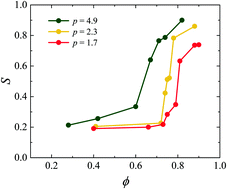2D isotropic–nematic transition in colloidal suspensions of ellipsoids†
Abstract
Liquid crystals are important condensed matter systems for technological applications, as well as for fundamental studies. An important unresolved issue is the nature of the phase transition in a two-dimensional (2D) liquid crystal system. In contrast to numerous computational studies reported in the last few decades, there have been no convincing experiments to verify these numerical results. Anisotropic colloids provide an excellent experimental model system to study phase transitions, such as crystallization and glass transition in condensed matter physics with single particle resolution. However, using colloids to probe the two-dimensional liquid crystal transition remains a challenge, since the condensed anisotropic colloids usually become stuck in the metastable glassy state rather than approaching their equilibrium liquid crystal phase. Here we report a method of using an external magnetic field to assist a colloidal system of super-paramagnetic anisotropic particles to overcome the local free energy barriers in the metastable states and approach the equilibrium phase. The experiments demonstrate a 2D isotropic–nematic phase transition with increasing packing density. The effects of the anisotropy of the colloidal particles on the 2D isotropic–nematic transition are explored. Our experimental results are compared with those from previous computational work, and quantitative agreements are reached.



 Please wait while we load your content...
Please wait while we load your content...